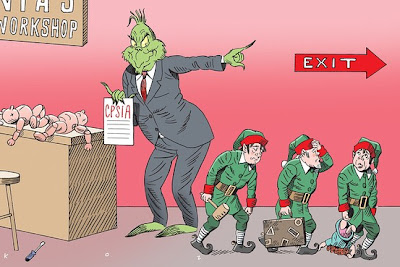
With February 10, 2010 fast approaching, the Handmade Toy Alliance has made a formal request to the CPSC for regulatory relief from the CPSIA through policy actions. We feel that these actions are absolutely necessary to save small batch childrens product manufacturing in the US.
Our fundamental belief is that the CPSIA focuses resources on processes rather than safety and needlessly hampers the Commission's ability to make product safety determinations based on risk. While we believe that only Congress can correct these issues, we have identified a number of areas where CPSC rulemaking based on common sense and risk analysis will prevent the needless destruction of hundreds of responsible small businesses.
The role of a federal agency is not just to enforce laws, but to give guidance to Congress. Our first request is for the CPSC to formally communicate to Congress that a technical amendment is needed to the CPSIA in order to correct its unintended consequences. Chief among these corrections would be to grant the CPSC discretion to apply risk analysis to the application of third party testing requirements and lead content limits.
We are also requesting a further one year stay of testing and certification requirements. We understand that the Commission will soon be issuing guidance on component testing rules under Section 102 of the CPSIA. However, these rules will arrive less than three months before the end of the current stay on February 10, 2010. This timeframe will provide little relief for manufacturers seeking to take advantage of component testing rules, who will need time to work with their component suppliers to assure upstream compliance.
Although the small batch community has already begun documenting CPSIA-compliant component suppliers (see cpsia-compliance.blogspot.com), without CPSC-issued regulations in place we have had little power to force suppliers to test and certify.
Third, we want the CPSC to consider the needs of small businesses when they issue rules regarding retesting requirements under Section 102(d)(2)(B) of the CPSIA. We understand that large toy manufacturers, represented by the Toy Industry Association (TIA), have been arguing for a tiered schedule for retesting. Their proposal would define three tiers of manufacturers based on whether their factories have obtained ISO-9001 ratings. Under this scheme, “Tier 1” factories would be allowed to test less frequently and under more favorable conditions while “Tier 3” would have to test more often under less favorable conditions.
While we can appreciate TIA's intention to reward higher volume factories that have demonstrated quality and safety control, their scheme is unfair and unworkable at the scale of small batch manufacturers. ISO-9001 certification can cost tens of thousands of dollars and is not applicable to home workshops and small domestic manufacturers.
We are therefore requesting that TIA's standards not be applied to our small businesses. Instead, we request a retesting schedule based on the number of items produced, not on any chronological time line. Retesting should be required every 10,000 units for small manufacturers, not every 15 months.
Fourth, many small toymakers are facing huge compliance costs because of required ASTM testing, which the CPSIA requires for all toys. We are asking the CPSC to issue an enforcement policy which would remove the threat of prosecution for small batch toymakers who are unable to afford ASTM testing. The products made by these manufacturers should still be required to meet ASTM requirements and the manufacturer shall be required to act in good faith
This would allow a company to deal with products based on volume. Small businesses will most likely be able to afford to test higher volume items, but they should still have an incentive to bring in niche, low volume items that meet ASTM but are not third party tested. This policy would be entirely justified based on risk analysis, since toys distributed in smaller quantities pose a smaller potential public health risk than mass market toys.
Although the Commission has issued exemptions from lead content and phthalate testing for many toys which are made from natural or other exempted materials, ASTM testing remains an insurmountable burden for many small toymakers. Even though ASTM testing is usually somewhat straightforward and simple to do, many testing labs have instituted minimum per-item testing fees of $300-$350, which largely negates any savings from natural material exemptions. Many of our members simply cannot afford to pay these fees and will be forced to cease operations without this relief. This issue not only affects handmade items, but also adaptive toys for children with disabilities, classroom supplies, and other low-volume specialty toy products
Fifth, we are asking the CPSC to issue a statement of enforcement policy that it will not prosecute makers of one-of-a-kind products for failure to test. Dozens of our member businesses earn their living by making custom products ranging from ceremonial Native American costumes to fabric dolls to hair bows. Testing these one-of-a-kind products is both physically and financially impossible.
And, we are asking the Commission to improve its education and outreach to small businesses by publishing a simplified explanation of testing requirements and ASTM toy standards, and by answering all of the questions posted on the site WhatIsTheCPSIA.com, where the small batch community has been attempting to share knowledge and interpret the requirements of the CPSIA.
We have also requested the CPSC to appoint an ombudsperson to help communicate with the small batch manufacturing community. Such an ombudsperson would serve to expedite answers to questions, give input to CPSC staff about policy decisions on behalf of small batch manufacturers, and work with organizations such as Etsy and the Handmade Toy Alliance to communicate with small batch manufacturers.
We also feel that CPSC-approved third-party testing labs require more transparency and oversight. We are requesting that the Commission require that all CPSC-certified labs, as a condition of their certification, abandon their per-item minimum fees and post itemized per-test costs so that small manufacturers can easily compare testing services. Our members have found the process of obtaining quotes from testing labs to be extremely arduous and time consuming. And, third party testing firms have been less than forthright about their fees, often quoting for tests which the CPSC does not require. These independent operators need more oversight from the CPSC to ensure that they are treating small businesses fairly.
Finally, we would like the CPSC to implement an education strategy for consumers. Media attention in the wake of mass market toy recalls has improperly skewed the public's understanding the primary sources of lead poisoning, which remain lead in house paint, dirt near highly-traveled roads, and workplace exposure. Lead awareness campaigns from the 1970s and 80s have now been forgotten by today's parents even though the same problems persist. The CPSC should take steps to re-educate the public about the highest-risk sources of lead exposure.
We feel that these actions, if adopted by the CPSC, would save hundreds of small American businesses whose companies had nothing to do with the recalls of 2007. Hopefully, the CPSC will respond favorably to our requests. Someday, perhaps, we will also have the chance to tell Congress directly about the effects the CPSIA is having on our businesses.
photo: Plush Dollhouse by Abbydid.
 CPSC Commissioner Anne Northup published an editorial today in the Wall Street Journal about the need for congress to make common sense reforms of the CPSIA.
CPSC Commissioner Anne Northup published an editorial today in the Wall Street Journal about the need for congress to make common sense reforms of the CPSIA. 












